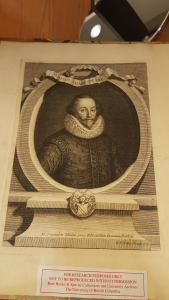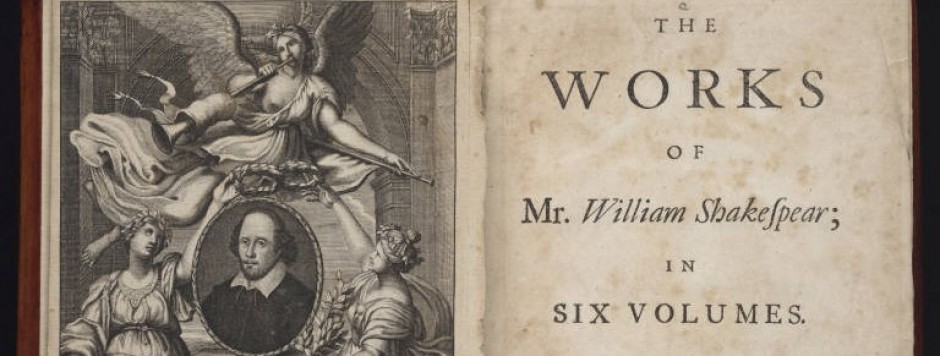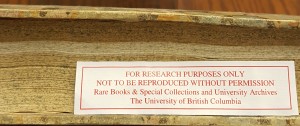
Fig. 1: Title Page of Volume One: Note the usage of colour ink to print this page, emphasizing the two step process it took to print this sheet since they would have had to reset the press for colour.
Alexander Pope’s The Works of Shakespear are printed in six volumes. The first volume contains the comedies “The Tempest”, “A Midsummer Night’s Dream”, “The Two Gentlemen of Verona”, “The Merry Wives of Windsor”, “Measure for Measure”, “The Comedy of Errors,” and “Much Ado About Nothing”. The second volume contains the comedies “The Merchant of Venice”, “Love’s Labour’s Lost”, “As You Like It”, “The Taming of the Shrew”, “All’s Well that Ends Well”, “Twelfth Night”, and “The Winter’s Tale”. Volume three contains Shakespeare’s historical plays: “King Lear”, “King John”, “King Richard II”, “King Henry IV” parts I-II, and “King Henry V”. Volume four contains the continuation of the historical plays, including “King Henry VI” parts I-III, “King Richard III”, and “King Henry VIII”. Volume five contains Shakespeare’s tragic plays from history: “Timon of Athens”, “Coriolanus”, “Julius Caesar”, “Antony and Cleopatra”, “Titus Andronicus”, and “Macbeth”. Volume six contains Shakespeare’s tragedies from fable: “Troilus and Cressida”, “Cymbeline”, “Romeo and Juliet”, “Hamlet”, and “Othello”. An interesting omission from the tragedies is “King Lear”, which Pope placed with Shakespeare’s historical plays in volume three.

Fig. 2: Shakespeare: The Latin text reads “Ad Originalem Tabulam penes Edwardum Dominum Harley” which translates to “From the original picture possessed by Edward, Lord Harley”. The date 1721, portrayed in the bottom right, emphasizes that the woodblock plate used to print this image was sculpted in 1721. Note the faint border (visible on the top left) around the edges that signify how the images were stamped onto the paper.
Volume one and six of Shakespear include unique pages. Volume one contains “The Preface of the Editor” written by Alexander Pope that details his intentions for his edition of Shakespeare. This preface also contains an explanation for his footnotes and the method he used to collate and edit the volumes. Volume one contains a few pages dedicated to “Some account of the life, &c. of Mr. William Shakespear”, a biographical piece written by Nicholas Rowe in 1709. Volume six contains an interesting “Index of the characters, sentiments, speeches and descriptors in Shakespear”, an inclusion that allows the reader to quickly look up key metaphors and scenes within the plays. Pope also includes “A table of the several editions of Shakespear’s plays, made use of and compared in this impression”, an inclusion that portrays the different editions of Shakespeare that Pope used to create his Shakespear. I go into detail on the significance of all of these pieces on my page dedicated to volumes one and six.
There are a few observations to make about the books before proceeding further. The volumes are printed and bound in folio format. Pages include numbers, however there is no table of contents in any of the volumes. The only way to navigate the texts is by referring to the index at the end of volume six, an index that does not focus on individual words but entire passages and poetic devices. Although there are page numbers, each page still includes catchwords to help guide the book binders putting the pages together (Fig. 5). A few pages have red and black ink, signifying a two-step printing process for those sheets (Fig. 1). The volumes possess various images with imprints around their edges, which reveal that they were created by stamping the pages with wood block engravings (Fig. 2). The binding for all six volumes is not the original 18th century binding, but possibly added a century later. The technique used to create the distinctive pattern on the cover is called paper marbling (Fig. 3). Paper marbling became increasingly popular in the 19th century for hard cover books and to rebind old books. Due to this popularity, one may estimate that these volumes of Pope’s Shakespear were rebound sometime during the Victorian era. Aside from the cover, the pages also show evidence of edge marbling (Fig. 4). To learn more about the process behind marbled paper, click here. The volumes possessed by Rare Books and Special Collections at UBC are in reasonably good condition. Only the spine on the fourth volume shows considerable damage. Most pages are free of tears and holes, however some demonstrate water damage. A common issue seen in all the volumes is that the ink tends to smudge on some pages, or leave an imprint on the opposite page (Fig. 5).



